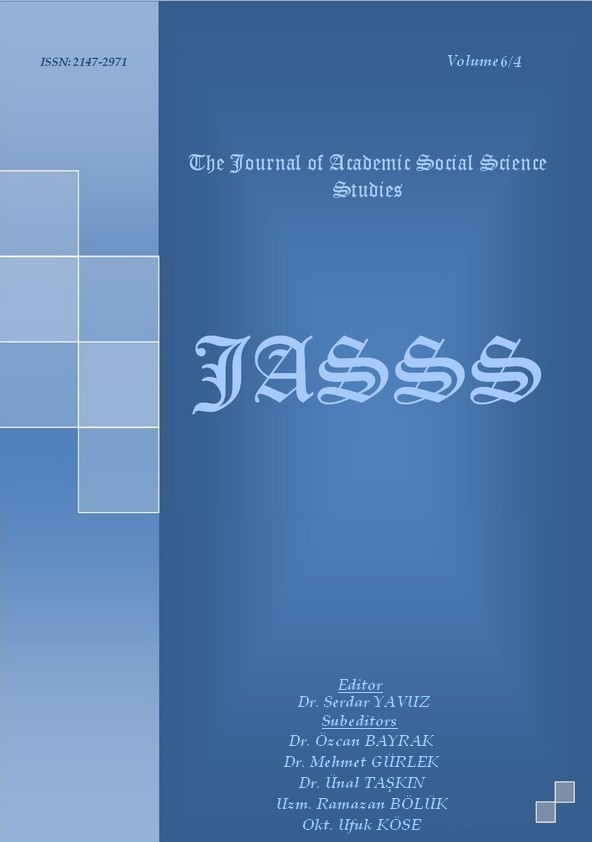Author :
Abstract
Çalışmamıza birleşik cümlenin tanımıyla başlanıp esas olarak ki bağlama edatı ve ki’li birleşik cümle kavramları üzerinde duruldu. Birleşik cümlenin tasnifi noktasında çeşitli görüşlere yer verildi ve bu görüş farklılıklarına değinildi. Bu farklılıkların geneli ki bağlama edatıyla kurulan birleşik yapıların birleşik cümle olarak kabul edilip edilmemesi üzerineydi ki bu yapılar birleşik cümle olarak değerlendirildi. Dilimize Hint-Avrupa dillerinden geçen ve yan cümleyi temel cümleye çeşitli ilgilerle bağlayan ki bağlama edatı ile ki’li birleşik cümleler hakkında çalışmanın başında geniş bir literatür taraması yapıldı. Konuyla ilgili kendi görüşlerimizi de belirttikten sonra ki bağlama edatının bağlayıcılık fonksiyonları üzerinde duruldu. Bu fonksiyonlar belirlenirken de “Tarık Buğra’nın Küçük Ağa Romanındaki Ki’li, Şartlı ve İç İçe Birleşik Cümleler” isimli Yüksek Lisans tezimde tespit ettiğimiz ki’li birleşik cümleler kullanıldı. Çalışmanın sonunda bu cümlelerden hareketle ki’nin bağlayıcılık fonksiyonları belirlenip aynı eserden verdiğimiz örneklerle de konu daha anlaşılır hale getirildi. Ayrıca ki’li birleşik yapıdaki örnekleri de Türkçe cümle yapısına uygun hale getirilip ilgili örneğin altında verildi. Böylece ki’li birleşik yapıların fiilimsiler yardımıyla nasıl düz cümle yapısına dönüştürüldüğü göstermiş olduk. İlave olarak son kısımda ki bağlayıcısı ile bağlanan birleşik yapıların bağladığı yan cümle ile temel cümlelerin isim cümlesi ya da fiil cümlesi olması durumuna göre tasnifini yapıldı. Bunlarla ilgili rakamsal veriler de çalışmamız içerisinde tablo halinde verildi.
Keywords
Abstract
This study is started with the definition of the compound sentence and the paper basically dealt with the concept of relative pronoun and compound sentences with “ki”. On the point of the classification of compound sentence, different views are included and mentioned. Most of these differences were on whether or not to accept compound sentences formed with relative pronoun as compound sentences, but they are accepted as compound sentence in the paper. As a beginning of the study, which is about relative pronoun and compound sentences with “ki” that passed from Indo-European languages to our tongue and connect the subordinate clause to the clause with various methods, a wide literature review is carried out. After giving personal opinions about the subject, the connecting functions of “ki” are emphasized. While deciding these functions the sentences used are taken from my MA thesis named “‘ki’ sentences, conditional clause and nested compound sentences in Küçük Ağa by Tarık Buğra”. At the end of the study, using these sentences, the connecting functions of “ki” is defined and the subject is made more understandable with the examples taken from the mentioned work. Furthermore, the examples of “ki” are adjusted to Turkish sentence structure and written beneath the related example. Thus, with the help of gerundial clauses we presented how the compound sentences with “ki” transformed into fundamental Turkish sentence structure. Additionally, in the last part of the study a classification of noun and verbal clauses, which were linked with compound sentences connected with “ki”, is made. The figures are given in chart in the study.
Keywords
- ATABAY, Neşe, ÖZEL Sevgi, ÇAM Ayfer, Türkiye Türkçesinin Sözdizimi, Papatya Yayınları, İstanbul 2003.
- BANGUOĞLU, Tahsin, Türkçenin Grameri, TDK Yayınları, Ankara 2004.
- BİLGEGİL, M. Kaya, Türkçe Dilbilgisi, Dergah Yayınları, 3.Baskı, İstanbul 1984.
- BOZKURT, Fuat, Türkiye Türkçesi, Kapı Yayınları, İstanbul 2004.
- BUĞRA, Tarık, Küçük Ağa, Ötüken Yayınları, İstanbul 1981.
- ÇAĞATAY, Saadet, “Türlçede ki
- DEMİR, Tufan, Türkçe Dilbilgisi, Kurmay Yayınları, Ankara 2004.
- DİZDAROĞLU, Hikmet, Tümce Bilgisi, TDK Yayınları, Ankara 1976.
- EDİSKUN, Haydar, Türk Dilbilgisi, Remzi Kitabevi, İstanbul 1999.
- EMRE, A. Cevat, Dilbilgisi, Hilmi Kitabevi, İstanbul 1951.
- ERGİN, Muharrem, Türk Dil Bilgisi, Bayrak Yayınları, İstanbul 2000.
- GENCAN, Tahir Nejat, Dilbilgisi, Ayraç Yayınları, Ankara 2001.
- GÜLENSOY, Tuncer, Türkçe El Kitabı, Akçağ Yayınları, Ankara 2000.
- HATİBOĞLU, A. Necip, Üniversitede Türk Dili Dersleri, Seçkin Yayınevi, Ankara 2000.
- HATİPOĞLU, Vecihe, Türkçenin Söz Dizimi, TDK Yayınları, Ankara 1972.
- HENGİRMEN, Mehmet, Türkçe Temel Dilbilgisi, Engin Yayınları, Ankara 1988.
- KARAHAN, Leyla, “Türkçede Birleşik Cümle Problemi”, Türk Gramerinin Sorunları Toplantısı, Türk Dil Kurumu, 22-23 Ekim 1993, Ankara.
- KARAHAN, Leyla, 1999. Türkçede Söz Dizimi, Akçağ Yayınları, Ankara, 167s.
- KARAHAN, Leyla, 2000. ”Yapı Bakımından Cümle Sınıflandırmaları Üzerine”, Türk Dili, Sayı(583), 16-23
- KARAÖRS, M. Metin, Türkçenin Söz Dizimi ve Cümle Tahlilleri, Erciyes Üniversitesi Yayınları, Kayseri 1993.
- KAYA, Fatih, 18.Yüzyıla Ait Bir Siyer-i Nebi’deki “Ki”li Birleşik Cümleler, The Journal of Academic Social Science Studies, Volume 5 Issue 4, p. 133-144, August 2012.
- KOÇ, Nurettin, Yeni Dilbilgisi, İnkılap Kitabevi, İstanbul 1996.
- KORKMAZ, Zeynep, Gramer Terimleri Sözlüğü, TDK Yayınları, Ankara 2007.
- MEHMEDOĞLU, Alaeddin, Türk Dilinde Bağımlı Birleşik Cümle Söz Dizimi, Aşiyan Yayınları, Adapazarı 2001.
- ÖZÇELİK, Sadettin, ERTEN, Münir, Türkiye Türkçesi Dilbilgisi, Set Matbaacılık, Diyarbakır 1999.
- SAVRAN, Hülya, “Birleşik Cümle Üzerine”, Türk Dili, Sayı:568, Nisan 1999, s. 325-330.
- SAVRAN, Hülya, “Eski Türkiye Türkçesinde Kim Bağlaçlı Yardımcı Cümleler”, TDAYB. 1999 I-II, TDK yay., Ankara 2003, s. 225-238.
- ŞİMŞEK, Rasim, Örneklerle Türkçe Sözdizimi, Trabzon 1987.
- TEKİN, Şinasi, “Uygurcada Yardımcı Cümleler Üzerine Bir Deneme”, TDAYB 1965, Ankara 1966, s. 35-63.
- TELLİ, Burak, “Tarık Buğra’nın Küçük Ağa Romanındaki Ki’li, Şartlı ve İç İçe Birleşik Cümleler”, Yayımlanmamış Yüksek Lisans Tezi, Kahramanmaraş Sütçü İmam Üniversitesi Sosyal Bilimler Enstitüsü, Kahramanmaraş, 2009.
- TOKATLI, Suzan, “Eski Anadolu Türkçesi Metinlerinde “ki”, “kim” Bağlama Edatı ve İlgi Zamirlerinin Zaman ve Kip Eklerine Yüklediği Görevler, Kırşehir Üniversitesi Kırşehir Eğitim Fakültesi, cilt:6, sayı:1, Kırşehir 2005, s. 133-148.
- TOKATLI, Suzan, Anadolu Ağızlarında Ki Bağlama Edatı İle Kurulan Yardımcı Cümleler, Erciyes Üniversitesi Sosyal Bilimler Dergisi, Sayı: 21, Yıl: 2006/2, s. 453
- TOPARLI, Recep, Türk Dili, Uzman Yayınları, Sivas 1996.
- TULUM, Mertol, Sinan Paşa, Maarifname ve Ki’li Birleşik Cümleler Üzerine Bir İnceleme, Basılmamış Doçentlik Tezi, İstanbul 1978.
- YAVUZ, Serdar, “Türkiye Türkçesi Ağızlarında Bağlaçlar”, Diyalektolog, Sayı 3, Kış 2011, s. 59-107
- YELTEN, Muhammet, “Pars-Name’deki Ki’li Birleşik Cümleler Üzerine”, MTAD., cilt:2, sayı 4, Ankara, Aralık 2005, s. 45-56.
- YILMAZ, Mustafa, ”Saltuk-Name’nin 2. Cildindeki Birleşik Cümleler Üzerine Bir Çalışma”; YL, Çukurova Üniversitesi, Sosyal Bilimler Enstitüsü, Adana 1998.
